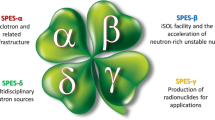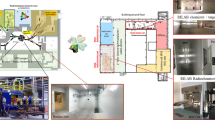Abstract
Radionuclides for radiopharmaceuticals can be produced in cyclotrons or nuclear reactors. Each of these production modes has serious issues, such as high target costs, production of long-lived wastes and contaminants, expensive separation. For this reason, new methods are under consideration for the production of highly pure radionuclides. The ISOL (Isotope Separation On-Line) method is the major technique for the production of radioactive ion beams for nuclear physics applications. The SPES-ISOLPHARM project at INFN-LNL (Istituto Nazionale di Fisica Nucleare-Laboratori Nazionali di Legnaro) is a feasibility study for the production of medical isotopes exploiting the ISOL method. The ongoing activities concerning a recent experiment focused on 111Ag, a study performed in collaboration with Padova and Trento Universities, is presented.



Similar content being viewed by others
References
Liu S (2008) Bifunctional coupling agents for radiolabeling of biomolecules and target-specific delivery of metallic radioisotopes. Adv Drug Deliv Rev 60(12):1347–1370
Nilsson T (2013) European RIB facilities—status and future. Nucl Instrum Methods Phys Res Sect B 317:194–200
Corradetti S (2015) Thermal conductivity and emissivity measurements of uranium carbides. Nucl Instrum Methods Phys Res Sect B 360:46–53
Manzolaro M (2010) Thermal-electric numerical simulation of a surface ion source for the production of radioactive ion beams. Nucl Instrum Methods Phys Res 623:1061–1069
Borgna F (2017) A preliminary study for the production of high specific activity radioisotopes for nuclear medicine obtained with the isotope separation on line technique. Appl Radiat Isot 127:214–226
Kuroda I (2012) Effective use of strontium-89 in osseous metastases. Ann Nucl Med 26:197–206
Yeong C (2014) Therapeutic radioisotopes in nuclear medicine: current and future prospects. J Zhejiang Univ Sci 15(10):845–863
Shi F (2014) Metastatic malignant melanoma: computed tomography-guided 125I seed implantation treatment. Melanoma Res 24(2):137–143
Rodrigues G (2013) Low-dose rate brachytherapy for patients with low or intermediate-risk prostate cancer: a systematic review. Can Urol Assoc J 7:463–470
Wyszomirska A (2012) Iodine-131 for therapy of thyroid diseases. Phys Biol Basis Nucl Med Rev Cent East Eur 15(2):120–123
Borgna F (2018) Early evaluation of copper radioisotope production at ISOLPHARM. Molecules 23:2437
Müller C (2017) Therapeutic radiometals Beyond 177Lu and 90Y: production and application of promising α-particle, β−-particle, and auger electron emitters. J Nucl Med 58:91S–96S
Müller C (2012) A unique matched quadruplet of terbium radioisotopes for PET and SPECT and for α- and β- radionuclide therapy: an in vivo proof-of-concept study with a new receptor-targeted folate derivative. J Nucl Med 53(12):1951–1959
Mastren Y (2018) Chromatographic separation of the theranostic radioisotope 111Ag from a proton irradiated thorium matrix. Anal Chim Acta 998:75–82
Vértes A (2011) Handbook of nuclear chemistry. Springer, Berlin
Aweda TA (2013) The use of Ag-111 as a tool for studying biological distribution of silver-based antimicrobials. MedChemComm 4:1015–1017
Liu S (2001) Bifunctional chelators for therapeutic lanthanide radiopharmaceuticals. Bioconjugate Chem 12:7–34
Brechbiel MW (2008) Bifunctional chelates for metal nuclides. Q J Nucl Med Mol Imaging 52(2):166–173
Gyr T (1997) A highly stable silver complex of a macrocycle derived from tetraazatetrathiacyclen. Angew Chem 36(24):2786–2788
Author information
Authors and Affiliations
Corresponding author
Additional information
Publisher's Note
Springer Nature remains neutral with regard to jurisdictional claims in published maps and institutional affiliations.
Rights and permissions
About this article
Cite this article
Andrighetto, A., Tosato, M., Ballan, M. et al. The ISOLPHARM project: ISOL-based production of radionuclides for medical applications. J Radioanal Nucl Chem 322, 73–77 (2019). https://doi.org/10.1007/s10967-019-06698-0
Received:
Published:
Issue Date:
DOI: https://doi.org/10.1007/s10967-019-06698-0




